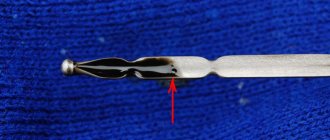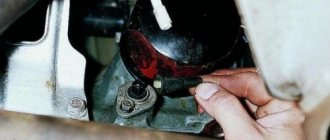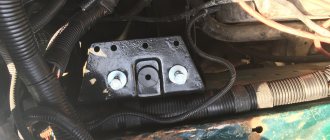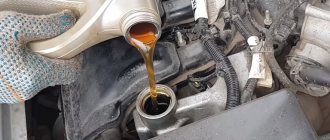An oil pressure sensor, or simply DDM, is a signaling device for the driver that displays the level of oil pressure in the engine. It usually turns on when the level drops noticeably. However, this element may also fail.
Replacing the Grant oil pressure sensor is a process that does not require phenomenal knowledge. You need to have a few tools and instructions on hand.
The DDM consists of three elements:
- Protective housing;
- Measuring membrane;
- Transmitting element.
The oil pressure light does not go out immediately when cold Lada Granta 2018
Hello everyone, I bought a second generation LADA GRANTA 18 year old eight valve in the winter of 19.
The oil pressure light is on for 8-10 seconds in winter, 2-4 seconds in summer, I didn’t notice it right away in winter because I was at the auto start when I noticed it, I went to the dealer with this problem. The dealer began to figure it out, changing the oil filters did not help. Changing the oil did not help "OIL WAS 5W40". We changed the oil pump twice and it didn't help. We changed the oil pressure sensor twice, but it didn't help either. They purged the cylinder head and cylinder block for blockages, but it didn’t help. We examined the end of the tube onto which the whole oil filter is screwed. The last thing that was changed was the cylinder head assembly, new from the factory. The problem still hasn't gone away. The service shrugs and doesn't know what's going on. I think that the Service needs to justify itself somehow, the service checked the oil pressure in the engine lubrication system is 3.5 kg/cm, the emergency oil pressure indicator turns off at the third second and wrote an ACT (checking the technical condition of the car) based on the results of the check - a malfunction in the lubrication system missing, decisions made - Operate the vehicle in accordance with the user manual. They gave me a document to sign, but of course I refused to sign. And for comparison, I had four, there was no such problem, there are two grants in the yard, they also don’t have such problems, I approached the owners of a similar car out of five cars, I found one with such a problem, he doesn’t worry, but I can’t do that. Who knows if there are regulatory tolerances for the burning of the oil pressure lamp or the Technical Instructions for the official method of troubleshooting and monitoring the engine lubrication system? Does anyone have literature of this nature?
Source
Where is the sensor located and its part number
The DDM is located on the right side of the engine and is screwed into the cylinder head. To replace it, you will need to remove the plastic decorative cover, after which the sensor will be immediately visible. Replacing the sensor itself is very simple, unscrew the old one and install the new one, no additional actions need to be performed.
The article number of the original oil pressure sensor is 11180-3829010-00 . Its cost may vary in different regions, but on average it ranges from 120 to 160 rubles.
The oil pressure light stays on for a long time when starting. Especially when it's cold. Plus video
Some of us, those who do maintenance ourselves , may encounter such a problem - after starting the engine, when it is cold (say, after night), the oil pressure lamp is on for a certain period of time. Maybe 3, 5, or even 10 seconds. Why does this happen, what are the reasons? Is this dangerous for the car and in particular for the engine and what should I do? Useful information, as well as a video version, read, watch...
THE CONTENT OF THE ARTICLE
What I want to say at the beginning is that guys, when the pressure lamp is on, it’s no longer good! After all, it cannot light up just like that, and must go out immediately after starting. That is, the engine started, the lamp went out and there shouldn’t be any 3 – 10 seconds! THIS IS ALREADY A DEVIATION FROM NORMAL OPERATION.
Faulty sensor
The oil pressure indicator may come on if the pressure sensor is faulty. The indication system works as follows: a sensor in the engine monitors the oil pressure, when it drops, the sensor shorts to ground and the warning lamp lights up; as the pressure increases, the circuit opens and the lamp goes out. If the sensor is faulty, it can close and open spontaneously, regardless of external factors.
If the lubricant level is normal, for diagnostics you can start the engine and raise the speed to 4-5 thousand. If the warning light does not go out, it is likely that the sensor has failed.
Why does it burn for a long time and then go out?
It's all simple guys - the problem is in the oil filter, it is because of it that this problem occurs. Let's remember how an oil filter works - the pump pumps oil pressure into the system, including the filter element, then the oil seeps through the filter paper, leaving behind dirt and other waste particles (chips, dust, dirt, burnt marks, etc.).
You need to understand that oil should not come out of the filter after stopping the engine. That is, the pump built up pressure into it, and it should remain there, that is, the lubricant should not return to the pan.
It is when the lubricant flows into the engine sump that the pump needs some time after starting to completely pump the system again. And at this time your pressure lamp is on. This takes from 3 to 10 seconds, it all depends on the manufacturer, design, volume, etc.
BUT why does the oil pressure hold in one filter element and not in the other? What is the reason? It's simple...
Replacing the sensor yourself
We remove the decorative plastic protection and put it aside so that it does not interfere
Carefully squeeze the clamps and remove the block from the sensor
Using a spanner or open-end wrench set to “21”, unscrew the sensor.
Now we will examine it and diagnose it according to the points that we described above.
We screw in the new sensor, connect the wire block and start the engine. If the oil pressure light goes out, then the problem was in the sensor; if not, you need to look for the cause further.
Video on the topic
For 15 years I have been repairing various types of cars, including brands such as VAZ, UAZ, Chevrolet, Mazda, Kia and many others. Everything related to the gearbox, engine or chassis. You can write me your question below in the comments and I will try to answer it in detail.
A very interesting article, for me, as a person who has his own car, this was not new to learn, but on the whole, I’m sure it will be great for beginners. After all, as a rule, in case of problems, they are the ones who take the car to the service center, they immediately come up with a thousand reasons and seem to change everything, but in fact they often change some small thing, including perhaps this sensor. By the way, it’s not difficult to change, everything was described correctly in the article, the main thing is to know where it is and of course another sensor, and in general, in my opinion, it’s better for us to learn how to make a car ourselves.
Well, you're handsome. Straight to the point comment. Now I know everything about replacing the sensor.
As soon as I didn’t press these damn clamps, the infection didn’t snap off, I just tore my fingers.
Squeeze the chip from both sides in the thick part at the same time from both sides. Help a little with a screwdriver like a spatula from the sensor side. When squeezed, the hooks will come off the sensor mushroom. It may turn out that while the engine is hot, the plastic will be more pliable than when it is cold.
The icon on the tidy goes out, everything is fine, but the BC writes an error, everyone checked the sensor, changed it 3 times, what is the problem, they didn’t find it, the error pops up every now and then
Anti-drainage valve as a reason
The so-called “anti-drainage valve” maintains the oil pressure inside the filter; it is this that “locks” the lubricating component inside. If this valve fails or is made of low-quality materials, then it will not work! Here's the reason.
But what is it, what does it consist of? Guys, essentially the valve is a banal rubber band, or now ordinary silicone. However, rubber (silicone) also comes in different qualities, and the assembly of the product also plays an important role.
It happens that immediately after changing the oil, a long extinguishment of the pressure lamp appears. This means either there is simply no rubber band (valve), or it has fallen off or torn (from “high” quality). THIS FILTER NEEDS TO BE CHANGED IMMEDIATELY! BECAUSE THE QUALITY IS SIMPLY “BELOW BELOW PINBOARD”, IT IS STILL NOT CLEAR WHAT IS THERE WITH THE FILTER PAPER.
It is also not uncommon for the light to start to light up after a certain mileage, say after 1000 - 3000 km. This also tells us that the anti-drainage valve is of poor quality, that is, the rubber has become “stiff” (or baked) from the high temperatures of the oil, and no longer holds it inside. It is also worth getting rid of such an element.
What you need to know about DDM?
A modern car has a large amount of electronics installed, based on the readings of which the electronic control unit issues the appropriate commands. One such device is the oil pressure sensor (OPS).
Appearance of DDM
Purpose and location
The purpose of the DDM is to monitor the oil level in the power unit; as soon as the amount of lubricant drops below the permissible level, the corresponding indicator light lights up on the instrument panel.
Device operation diagram
The operating principle can be described as follows. Lubricant is supplied to all components of the system under pressure. The system includes a DDM, inside of which there is a membrane indicated by arrow 4. If the pressure is low, then the membrane is not deformed, the contacts numbered 3 are closed and the lamp indicated by arrow 2 is on.
When the engine starts, the pressure increases, the membrane is deformed and acts on the pusher that is installed on it. In this case, the contacts open and the light goes out.
The DDM is located on the cylinder head on the right, when viewed in the direction of travel, on the back side of the engine. It receives power through a wire with a plastic terminal, which makes it easy to detect.
Device location
Diagnostic features
If the indicator on the dashboard is constantly on, you should first check the oil level using a dipstick and the condition of the oil filter. It is also necessary to check for oil stains on the power unit housing. If the level is normal, you should check the device itself. The simplest test option is to install a known-good device instead of the device being tested.
You don’t have to buy a new one, you can ask your neighbor in the garage. True, the sensor should be exactly the same. If, after installing a working device, the indicator stops lighting, then the removed one is faulty.
In addition, using a multimeter, the power supply to the device is checked to see if there is an open circuit. If you have a pressure gauge, you can check the oil pressure. To check, you need to screw the pressure gauge into the DDM seat and start the engine. At idle, the pressure value should be above 0.65 kgf/cm2.
If you don't have a pressure gauge, there is another way to check. To do this, the sensor is unscrewed, and then the starter is cranked without starting the engine. If, when the starter rotates, oil splashes from the seat of the removed device, we can conclude that the device is faulty.
Is it dangerous or is it safe to drive like this?
Often on some forums, I read: “okay, it’s no big deal, you can drive like that, well, just think, it caught fire, then went out, everything seems to be fine”!
Guys, this is a very erroneous opinion, if only simply because after starting the engine runs almost “dry” for several seconds. At this time, there is simply catastrophic wear of parts. Especially in the winter, cold period, the oil is already cold, plus there is no engine lubrication.
With this approach, the capital of the engine is not far away. And guys, a filter costs a penny, a good one costs from 300 to 500 rubles, well, don’t skimp, overpay 100 - 200 rubles, don’t buy the “crap” option, but you’ll ride calmly, as they say - no problems.
I think my message has reached you, now we are watching the video version of the article.
This is where I end, I think my article was useful to you.
(
32 votes, average: 4.63 out of 5)
Similar news
Is it necessary to warm up the engine? Before the trip? Let's analyze winter and summer.
Sensors for an injection engine. Let's look at the VAZ as an example
About LADA car sensors and engine management system
12 October 2015 LadaOnline 159 004
Various sensors are responsible for the operation of all systems of a modern car. They take readings and transmit them to the electronic engine control unit (ECU). If the sensor malfunctions, an error is stored in the memory, and in some cases a Check Engine error appears on the instrument panel.
Where are the sensors located?
All modern Lada cars (Granta, Kalina, Priora, Vesta, Largus, Niva or Lada XRAY) are equipped with domestic VAZ engines. The location of the sensors on these motors is the same:
Elements of the electronic engine control system of the VAZ 11186/11189: 1* – controller; 2* – crankshaft position sensor; 3* – control oxygen concentration sensor; 4* – diagnostic block; 5* – diagnostic oxygen concentration sensor; 6 – throttle control unit; 7* – vehicle speed sensor; 8* – adsorber purge valve; 9* – gas pedal module; 10* – brake signal switch; 11* – clutch pedal position sensor; 12 – battery; 13 – mass air flow sensor; 14 – coolant temperature sensor; 15 – ignition coil; 16 – knock sensor; 17 – spark plugs; 18* – nozzles. *The item is not visible in the photo.
The oil pressure light does not go out for a long time when starting a cold Grant engine
It started after an oil change. I blame the orange “FRAM” filter (the first time I had the same light, the light went out immediately after starting) it looks like the check valve is dead. Or am I wrong?
Should I change the filter or is this normal?
I filled the oil with essso ultron (for the second time already). mileage 13tkm.
It started after an oil change. I blame the orange “FRAM” filter (the first time I had the same light, the light went out immediately after starting) it looks like the check valve is dead. Or am I wrong?
Should I change the filter or is this normal?
I filled the oil with essso ultron (for the second time already). mileage 13tkm.
I would change the filter
I'll change it over the weekend. I'll write a report
.
Shouldn't it be burning? the manuals say that this is normal 2-3 seconds immediately after startup
IMHO Not entirely true. The lamp only lights up after a long stop (overnight), when the oil has time to drain from the system into the engine crankcase.
It turns out that with each such launch the effect of the “first launch” is obtained, i.e. The engine oil system is empty and until it is filled with oil the lamp just stays on.
Z.Y. on a penny, the lamp went out already when the starter was turned.
It was the same bullshit. Also a Fram filter. Now I install Finvale and change it at five thousand.
Why is there a filter for every 5? change. Well, it’s better to drive without boot and there is little benefit from it, it’s better to pour normal oil and install normal filters and not look for something cheaper.










